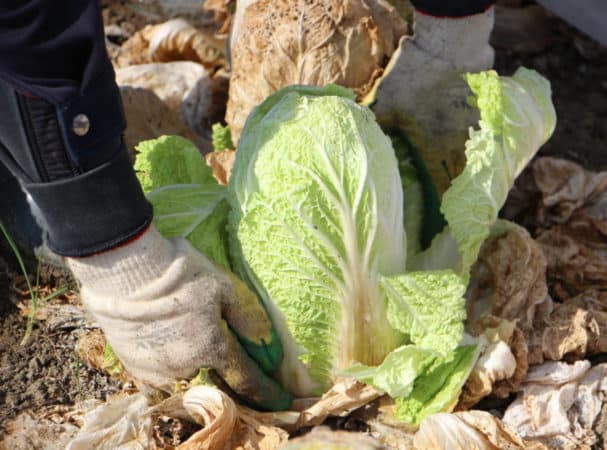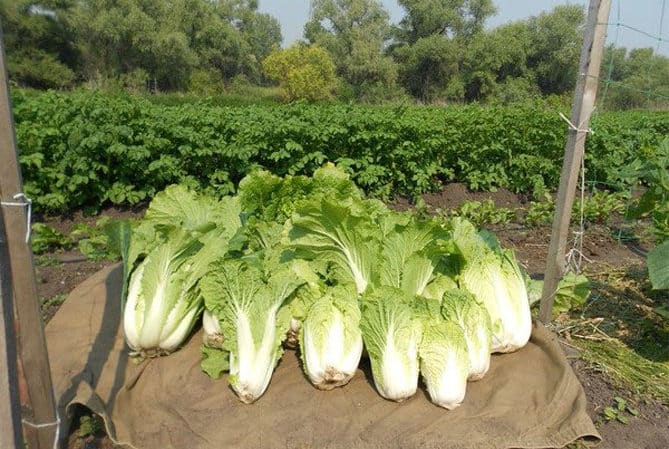Harvesting in a timely manner: when to harvest Chinese cabbage from the garden and what determines the harvest time
Beijing cabbage grows beautifully in the beds of our country. Its leaves are suitable for vegetable salads, and the heads of cabbage can be stored for several months and will delight vitamin lovers in winter. Knowledge of the peculiarities of agricultural technology of this crop allows you to get several good harvests a year. When to remove Chinese cabbage from the garden, read the article.
Harvesting time for Chinese cabbage

Beijing It is recommended to collect in dry weather. Heads of cabbage are stored in boxes in a dark room at zero temperature. Pekinka harvest time and shelf life depend on the variety.
Cold-resistant varieties can withstand temperatures down to -5°C. You don't have to rush into cleaning. Varieties planted in mid-summer ripen in September.
Late ones are harvested in mid-October. Early ripening ones are used for salads, for winter storage they don't fit. Cabbage planted in July is stored until the New Year holidays.
How to determine when it's time to harvest
Harvesting depends on the climatic conditions of the area where the crop is grown. The first frosts in the fall become a signal for gardeners that it is time to start harvesting.
If the thermometer approaches zero at night and does not rise above +10ºC during the day, then it’s time to start cleaning. Untimely harvest will bloom.
By timing
The cabbage is cut when the head is formed. 40 days after germination, you can enjoy the first vegetables at the end of June.It is during this period that the early varieties of Pekinka ripen, which are suitable for preparing delicious dishes, but it will not be possible to preserve the heads of cabbage for a long time.
Late varieties of cabbage ripen only in the fall, but it is their forks that are suitable for long-term storage under optimal conditions. Gardeners believe that when harvesting cabbage, it is better to be a little late than to hurry.
By external signs
Cabbage harvesting begins when the leaves of its head close. The weight of the heads of cabbage should be slightly more than 1 kg. When they stop growing and become hard, it is harvest time. It is better to determine readiness by touch. The head of cabbage should be dense, but not loose.
When to harvest Chinese cabbage depending on the variety
Breeders delight with a huge number of varieties of Chinese cabbage, each of which has its own ripening time and can be grown in any climate, subject to planting and care conditions.
Agronomists distinguish 3 types of cabbage based on ripening time:
- early ripening varieties, ripening 40 days after sowing;
- mid-season, which are ready for harvest in 60 days;
- late-ripening, ready for consumption 80 days after planting.
Depending on the growing region
In the central regions of Russia, the first harvest begins in mid-summer. Gardeners carry out the second harvest in mid-October.
The southern regions of the country have been enjoying harvests since mid-November. Early varieties are best planted in greenhouses. In the south of Russia, to reduce daylight hours, plants are shaded.
Favorable time for harvesting according to the lunar calendar 2020
The moon can have a significant impact on plants. Astrologers draw up special calendars that help to properly plan work in the garden.
When the Moon is in Water signs, cabbage cannot be cut for long-term storage. During the growth of the Moon, nutrients accumulate in the Peking cone, so it is not recommended to disrupt the process and harvest during this period. The most suitable and favorable time for harvesting vegetables is the days of the new moon and full moon.
Favorable days in 2020:
- August – 1-2, 4, 10-14, 28-29, 31;
- September – 1, 4-10, 24-28;
- October – 1-12, 21-25, 28-31;
- November – 1-9, 18-21, 25-30.
Cleaning technology
An adult Pekin is frost-resistant and can withstand temperatures down to -4°C. If cabbage is harvested for long-term storage, it is better to cut the heads before frost. It is recommended to harvest the crop in dry weather to avoid morning dew. Otherwise, moisture will contribute to the rotting of the vegetable.
Unripe small stalks of Chinese cabbage can be safely left in the garden until mid-October. When a head of Chinese cabbage becomes dense, it is ready for harvesting.

Preparation for storage
Choose a cool and dry autumn day. Even slight damage to the head of cabbage reduces the shelf life, because it creates fertile ground for the proliferation of fungi. The cabbage is sorted. All burst heads of cabbage, with damage and broken leaves are sent for processing. Only large and solid cones without spots, inclusions, or damaged leaves are suitable for long-term winter storage.
The heads of cabbage are cut off at the base with a knife. After this, Chinese cabbage intended for sale is immediately cleared of yellow and broken leaves, wrapped in film and placed vertically in a cardboard or wooden box. When laid horizontally, tender heads of cabbage are subjected to pressure on each other and are poorly stored.
The assembled forks are stored in a cool and dry room with a temperature range from 0 to +2°C. Cabbage should not be dumped into a common pile. Vegetables love space, so storing them requires special boxes or racks.
Some gardeners hang nets from the ceiling where elastic heads of cabbage are placed. Periodic inspection for dried leaves and rot will help keep your forks longer. Detection of traces of gray mold requires urgent ventilation of the basement. Humidity and temperature will drop, making it more difficult for putrefactive bacteria to multiply.
It is better to collect Pekinka in the morning or evening. To prevent the head of cabbage from wilting and losing its presentation, it is packaged in cling film. Peking cabbage is stored in the refrigerator for about 2 weeks, and at a temperature of 2 to 4°C for up to 3 months.
Important! Peking cabbage, ripened before frost - in mid-October, is suitable for long-term preservation.

How to harvest Chinese cabbage twice per season
Seeds are sown after the first harvest, no later than mid-August. After this period, daylight hours are greatly reduced, and the cabbage will not have time to form conical heads. To grow 2-3 cabbage crops per season, it is necessary to create suitable conditions for each variety, taking into account the climate.
Some gardeners grow vegetables year-round in heated greenhouses. For the plant to develop well, it is enough to maintain the temperature within +20°C.
How to store crops correctly
Vegetables planted in early spring are not suitable for long-term storage; they are planted specifically for summer use. But Chinese cabbage, planted in July, is perfectly stored until the new year and beyond.To keep the forks juicy and fresh, the plant is taken out by the roots and buried in damp sand in a basement with good ventilation. To prevent the plant from withering, it is well watered.
For transportation, mature and dry forks without damage are selected. The shelf life is 3 months. During this period, the product retains all its beneficial qualities.
Important! If cabbage was grown on soil fertilized with nitrogen additives, the crop will not be stored for long. This cabbage needs to be processed quickly.
You cannot store cabbage next to apples, otherwise it will spoil. Immediately after collection, the forks are wrapped in film.
Conclusion
Chinese cabbage does not require careful care. To get a decent harvest, choose the right variety and calculate the timing of planting seedlings and transferring them to open ground. Inexperienced gardeners are better off working with hybrids. If you follow the rules of collection and storage, this delicious vegetable will be on your table all winter.